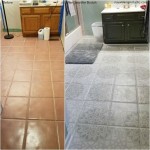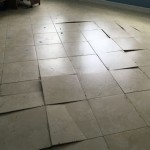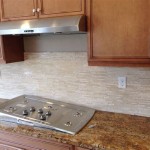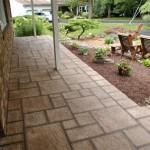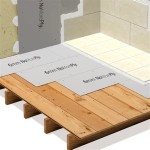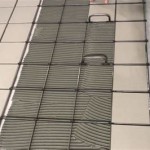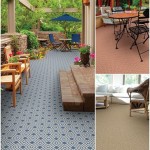Do You Have To Put Backer Board Under Tile?
The question of whether backer board is necessary under tile is a common one for both novice and experienced DIYers undertaking tiling projects. The straightforward answer is generally yes, especially in wet areas like bathrooms and kitchens. However, the necessity of backer board depends on several factors, including the substrate, the type of tile being used, and the intended use of the tiled area. Understanding these factors is crucial for a successful and long-lasting tiling installation.
Backer board, also known as cement board or tile backer, is a specialized building material designed to provide a stable and water-resistant substrate for tile. It is typically composed of cement, reinforced with fiberglass mesh or other materials, and comes in sheets of varying thicknesses. Unlike plywood or drywall, which can warp, rot, or crumble when exposed to moisture, backer board is specifically engineered to withstand prolonged exposure to water and humidity, making it an ideal choice for tiled surfaces in damp environments.
The primary purpose of backer board is to create a rigid, stable, and waterproof foundation for tile. This is crucial because tile installations rely on a solid substrate to prevent cracking and ensure the longevity of the tiled surface. Without a proper substrate, the tile may be susceptible to movement, which can lead to grout failure, cracked tiles, and ultimately, the need for costly repairs.
Key Point 1: The Role of Backer Board in Moisture Resistance
One of the most significant benefits of using backer board is its superior moisture resistance compared to other common building materials. Wood-based substrates, such as plywood and OSB (oriented strand board), are susceptible to water damage. When exposed to moisture, these materials can swell, warp, and even rot, compromising the integrity of the tile installation. Drywall, while suitable for some dry applications, is also vulnerable to moisture and can crumble if it becomes wet.
Backer board, on the other hand, is designed to resist moisture penetration. The cementitious composition of the board prevents it from absorbing water, minimizing the risk of swelling, warping, or rotting. This is particularly important in areas that are frequently exposed to water, such as showers, tub surrounds, and kitchen backsplashes. By providing a moisture-resistant substrate, backer board helps to protect the underlying structure from water damage and ensures the long-term durability of the tile installation.
Furthermore, many backer boards are treated with a waterproof coating or membrane, further enhancing their resistance to moisture. These coatings create a barrier that prevents water from penetrating the board, even in high-moisture environments. When installing tile in wet areas, it is often recommended to use a backer board with a waterproof coating or membrane, along with a waterproof sealant at the seams, to provide maximum protection against water damage.
It is essential to note that while backer board is moisture-resistant, it is not completely waterproof. Water can still penetrate through seams and fastener holes if they are not properly sealed. Therefore, it is crucial to use waterproof sealant and tape at all seams and fastener locations to create a continuous waterproof barrier. The combination of moisture-resistant backer board and proper sealing techniques is essential for ensuring a long-lasting and waterproof tile installation.
Key Point 2: Providing a Stable and Durable Substrate
Another critical function of backer board is to provide a stable and durable substrate for tile. Tile installations require a rigid and unyielding surface to prevent cracking and ensure the longevity of the tiled surface. Substrates that are prone to flexing, movement, or vibration can cause the tile to crack or become dislodged over time.
Backer board is significantly more rigid and stable than wood-based substrates or drywall. Its cementitious composition and reinforcement with fiberglass or other materials give it exceptional strength and resistance to deformation. This rigidity helps to distribute the weight of the tile evenly and prevents the substrate from flexing or moving under load.
The stability provided by backer board is particularly important for larger format tiles, which are becoming increasingly popular in modern tile installations. Larger tiles are more susceptible to cracking if the substrate is not sufficiently rigid. The added weight and size of these tiles require a stable foundation to prevent them from flexing or moving, which can lead to stress fractures and grout failure.
In addition to its rigidity, backer board is also highly resistant to impact damage and wear. This makes it an ideal choice for high-traffic areas, such as floors and countertops. The durable surface of the backer board can withstand the constant wear and tear of daily use, ensuring that the tile installation remains intact and aesthetically pleasing for years to come.
To ensure optimal stability, it is important to install backer board correctly. This includes using the appropriate fasteners, spacing them properly, and ensuring that the board is securely attached to the underlying framing. A properly installed backer board will provide a solid and stable foundation for the tile, minimizing the risk of cracking and ensuring the long-term durability of the tiled surface.
Key Point 3: Alternative Substrates and When They Might Be Acceptable
While backer board is generally recommended for most tiling projects, there are some situations where alternative substrates may be acceptable. However, careful consideration of the specific conditions and requirements of the project is essential before opting for an alternative substrate.
One alternative substrate is a pre-sloped shower pan system. These systems are designed to create a waterproof surface for shower floors and typically consist of a pre-formed pan made of acrylic or other waterproof material. These systems often integrate the drain and provide a ready-to-tile surface. While these systems are convenient and can save time, it is important to ensure that they are properly installed and that the tile is compatible with the pan material.
Another alternative is using a waterproofing membrane directly over plywood. This method involves applying a liquid or sheet membrane to the plywood surface to create a waterproof barrier. However, this approach is generally not recommended for wet areas like showers or tub surrounds, where the risk of water damage is high. Plywood, even when covered with a waterproof membrane, is still susceptible to moisture penetration and may warp or rot over time. Additionally, the movement inherent in plywood can pose challenges for tile adherence and grout lines. If this method is chosen, it must be done with extreme care and in accordance with industry best practices and manufacturer specifications, and might only be suitable for splashbacks with limited water exposure.
In certain cases, a specifically modified form of drywall, sometimes referred to as "green board" or "blue board," may be acceptable for tiling in areas with low moisture exposure, such as dry bathroom walls away from the shower or tub. However, even these moisture-resistant drywall products are not as durable or water-resistant as backer board and should not be used in areas that are frequently exposed to water. Moreover, any use of moisture-resistant drywall that will be tiled should consult the drywall manufacturer's specifications and recommendations before proceeding.
When considering alternative substrates, it is crucial to evaluate the following factors: the level of moisture exposure, the size and type of tile being used, the structural integrity of the substrate, and any applicable building codes or regulations. If there is any doubt about the suitability of an alternative substrate, it is always best to err on the side of caution and use backer board to ensure a durable and long-lasting tile installation.
Ultimately, the choice of substrate depends on the specific requirements of the tiling project. However, in most cases, backer board provides the best combination of moisture resistance, stability, and durability, making it the preferred choice for tile installations, especially in wet areas. By understanding the benefits of backer board and following proper installation techniques, it is possible to create a tile surface that is both beautiful and long-lasting.
It's important to always consult local building codes and manufacturer's instructions for specific guidance related to the type of tile, location, and substrate being used. These resources offer valuable information that can help ensure a successful and code-compliant tiling project.

How To Install Cement Board The Home Depot

How To Install Cement Board On A Floor Diy Family Handyman

Tile Backerboard Material Options Fine Homebuilding

How To Install Cement Board The Home Depot

How To Install Hardiebacker Cement Board On Floors James Hardie Pros

Tile Backer Board Benefits Uses Insulation

Installing Cement Backerboard For Tile Flooring Hometips

Tiling On Wooden Floors Part 4 Overboarding Bathroom Guru

How To Install Cement Backer Board For Floor Tile Installation The Home Depot

Tile Installation Backer Board Around A Bathtub Family Handyman
Related Posts

